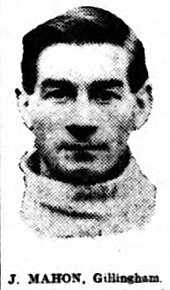|
1911–12 New Brompton F.C. season
During the 1911–12 English football season, New Brompton F.C. competed in the Southern League Division One. It was the 18th season in which the club competed in the Southern League and the 17th in Division One. At the end of the season, the club changed its name to Gillingham F.C. Gillingham also competed in the FA Cup, losing in the fourth qualifying round. The team played 39 competitive matches, winning 11, drawing 9, and losing 19. Fred Corbett, Abel Lee, and Jock Taylor were the joint highest goalscorers, with six goals each. Jack Mahon made the most appearances, playing in every game. Background and pre-seasonNew Brompton, founded in 1893,[2] had played in the Southern League since the competition's formation in 1894.[3] At the time, only a small number of teams from the south of England had been elected into the ostensibly national Football League, with many of the south's leading teams playing in the Southern League.[4] The 1911–12 season was the club's 17th season in Division One, the league's top division, following promotion from Division Two at the first attempt in 1895. As was often the case in the early 20th century, the club did not employ a full-time team manager; most tasks associated with a modern manager, such as the signing of new players, were among the responsibilities of the club's secretary, William Ironside Groombridge.[5] J. Craddock was newly appointed to the position of team trainer.[1] A number of players who had been regulars during the previous season left the club, and constraints caused by a significant financial loss over the course of the previous twelve months made it hard to recruit good-quality replacements.[1] New Brompton signed two new half-backs, Abel Lee and Tom Kelly, both of whom had previously played for Grimsby Town.[1] Forwards joining the club included Dick Goffin from Clapton Orient and Edward Whiteside, formerly of Norwich City.[1] No new goalkeepers were signed, but it was anticipated that Albert Bailey, the goalkeeper for the club's reserve team during the previous season, would step up to the first team in place of Thomas Holmes, one of the departing players.[1] The team wore New Brompton's usual black and white kit.[6] Southern League Division OneSeptember–December The club's first match of the season was on 2 September at their own ground, Priestfield Road, against Luton Town;[7] Kelly, Goffin, and Whiteside all made their debuts.[8] Whiteside had several shots on goal for New Brompton but the match finished 0–0.[7] January–AprilBeginning on 30 March, New Brompton won four consecutive games; having scored only once in 14 previous games since joining the club, Corbett scored five times in the four matches. New Brompton's final game of the season was away to Plymouth Argyle.[8] League match details
Partial league table
Source: [citation needed] FA CupAs a Southern League Division One team, Gillingham entered the 1911–12 FA Cup at the fourth qualifying round stage; their opponents were Croydon Common of the Southern League Division Two. New Brompton took a 2–0 lead but the referee abandoned the game due to heavy rainfall.[9] Cup match details
Players  During the season, 23 players made at least one appearance for New Brompton. Jack Mahon made the most, playing in every game. Andrew Mosley was absent for only one game, and Bailey, Lee, and Taylor missed only two matches. At the other end of the scale, Charlie Frost and C. Gudgeon played only once; in Gudgeon's case it was the only appearance he made for New Brompton. Lee, Taylor, and Fred Corbett were joint top goalscorer with six goals each.[8] This was the lowest figure with which a player had ended the season as New Brompton's top scorer since the 1905–06 season.[10]
FW = Forward, HB = Half-back, GK = Goalkeeper, FB = Full-back a. ^ The abandoned first match against Croydon Common is not included. AftermathOn 6 June, the club's board of directors took the decision to change the club's name to Gillingham Football Club to reflect the fact that in the decades since the club's formation the previously small settlement of Gillingham had outgrown and absorbed New Brompton. The name change would not be formally approved by the shareholders until the following summer; nonetheless the team played under the new name in the 1912–13 season.[11] Along with the new name, the club adopted a new kit featuring red shirts with blue sleeves, replacing the previous black and white stripes, and for the first time added the coat of arms of the borough to the shirts.[6] References
Works cited
|
||||||||||||||||||||||||||||||||||||||||||||||||||||||||||||||||||||||||||||||||||||||||||||||||||||||||||||||||||||||||||||||||||||||||||||||||||||||||||||||||||||||||||||||||||||||||||||||||||||||||||||||||||||||||||||||||||||||||||||||||||||||||||||||||||||||||||||||||||||||||||||||||||||||||||||||||||||||||||||||||||||||||||||||||||||||||||||||||||||||||||||||||||||||||||||||||||||||||||||||||||||||||||||||||||||||||||||||||||||||||||||||||||||||||||||||||||||||||||||||||||||||||||